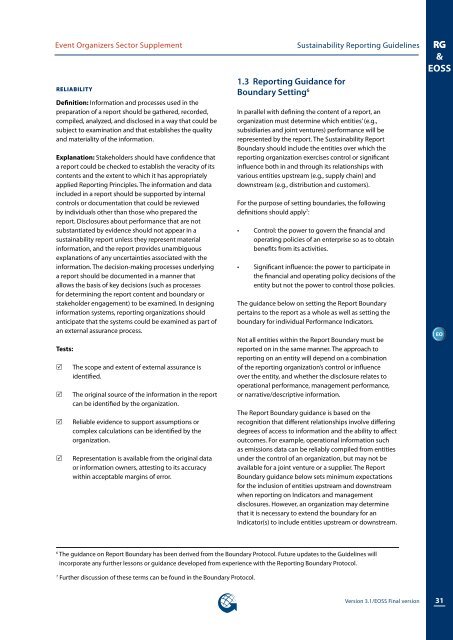Event Organizers Sector Supplement - Global Reporting Initiative
Event Organizers Sector Supplement - Global Reporting Initiative
Event Organizers Sector Supplement - Global Reporting Initiative
Create successful ePaper yourself
Turn your PDF publications into a flip-book with our unique Google optimized e-Paper software.
<strong>Event</strong> <strong>Organizers</strong> <strong>Sector</strong> <strong>Supplement</strong><br />
Reliability<br />
Definition: Information and processes used in the<br />
preparation of a report should be gathered, recorded,<br />
compiled, analyzed, and disclosed in a way that could be<br />
subject to examination and that establishes the quality<br />
and materiality of the information.<br />
Explanation: Stakeholders should have confidence that<br />
a report could be checked to establish the veracity of its<br />
contents and the extent to which it has appropriately<br />
applied <strong>Reporting</strong> Principles. The information and data<br />
included in a report should be supported by internal<br />
controls or documentation that could be reviewed<br />
by individuals other than those who prepared the<br />
report. Disclosures about performance that are not<br />
substantiated by evidence should not appear in a<br />
sustainability report unless they represent material<br />
information, and the report provides unambiguous<br />
explanations of any uncertainties associated with the<br />
information. The decision-making processes underlying<br />
a report should be documented in a manner that<br />
allows the basis of key decisions (such as processes<br />
for determining the report content and boundary or<br />
stakeholder engagement) to be examined. In designing<br />
information systems, reporting organizations should<br />
anticipate that the systems could be examined as part of<br />
an external assurance process.<br />
Tests:<br />
R<br />
R<br />
R<br />
R<br />
The scope and extent of external assurance is<br />
identified.<br />
The original source of the information in the report<br />
can be identified by the organization.<br />
Reliable evidence to support assumptions or<br />
complex calculations can be identified by the<br />
organization.<br />
Representation is available from the original data<br />
or information owners, attesting to its accuracy<br />
within acceptable margins of error.<br />
1.3 <strong>Reporting</strong> Guidance for<br />
Boundary Setting 6<br />
Sustainability <strong>Reporting</strong> Guidelines<br />
In parallel with defining the content of a report, an<br />
organization must determine which entities’ (e.g.,<br />
subsidiaries and joint ventures) performance will be<br />
represented by the report. The Sustainability Report<br />
Boundary should include the entities over which the<br />
reporting organization exercises control or significant<br />
influence both in and through its relationships with<br />
various entities upstream (e.g., supply chain) and<br />
downstream (e.g., distribution and customers).<br />
For the purpose of setting boundaries, the following<br />
definitions should apply 7 :<br />
• Control: the power to govern the financial and<br />
operating policies of an enterprise so as to obtain<br />
benefits from its activities.<br />
• Significant influence: the power to participate in<br />
the financial and operating policy decisions of the<br />
entity but not the power to control those policies.<br />
The guidance below on setting the Report Boundary<br />
pertains to the report as a whole as well as setting the<br />
boundary for individual Performance Indicators.<br />
Not all entities within the Report Boundary must be<br />
reported on in the same manner. The approach to<br />
reporting on an entity will depend on a combination<br />
of the reporting organization’s control or influence<br />
over the entity, and whether the disclosure relates to<br />
operational performance, management performance,<br />
or narrative/descriptive information.<br />
The Report Boundary guidance is based on the<br />
recognition that different relationships involve differing<br />
degrees of access to information and the ability to affect<br />
outcomes. For example, operational information such<br />
as emissions data can be reliably compiled from entities<br />
under the control of an organization, but may not be<br />
available for a joint venture or a supplier. The Report<br />
Boundary guidance below sets minimum expectations<br />
for the inclusion of entities upstream and downstream<br />
when reporting on Indicators and management<br />
disclosures. However, an organization may determine<br />
that it is necessary to extend the boundary for an<br />
Indicator(s) to include entities upstream or downstream.<br />
RG<br />
&<br />
EOSS<br />
EO<br />
6<br />
The guidance on Report Boundary has been derived from the Boundary Protocol. Future updates to the Guidelines will<br />
incorporate any further lessons or guidance developed from experience with the <strong>Reporting</strong> Boundary Protocol.<br />
7<br />
Further discussion of these terms can be found in the Boundary Protocol.<br />
Version 3.1/EOSS Final version<br />
31

















